Footy Grounds

Collingwood "Victoria Park Oval"
The Collingwood Football Club was established in 1892.
The timber stand erected that year was designed free of charge by the local councillor and MLC, W. Pitt, who was also the architect of the Princess Theatre and the Melbourne Stock Exchange.
The long, low pavilion on the right of the painting seated 300 and was built in 1900 (extended in 1902) to accommodate ladies who purchased between a fifth and a quarter of the tickets. One observer suggested at the time: “It will also protect some of the more delicate members from the umbrellas and worse of the women.”
It was not unusual at the turn of the century to see some players wearing hats on the field during the game as protection from the weather. Despite the violence and rough-house tactics employed by many players of that era, the game was slow enough to enable hat-wearing.
Richard Stremski Club Historian.
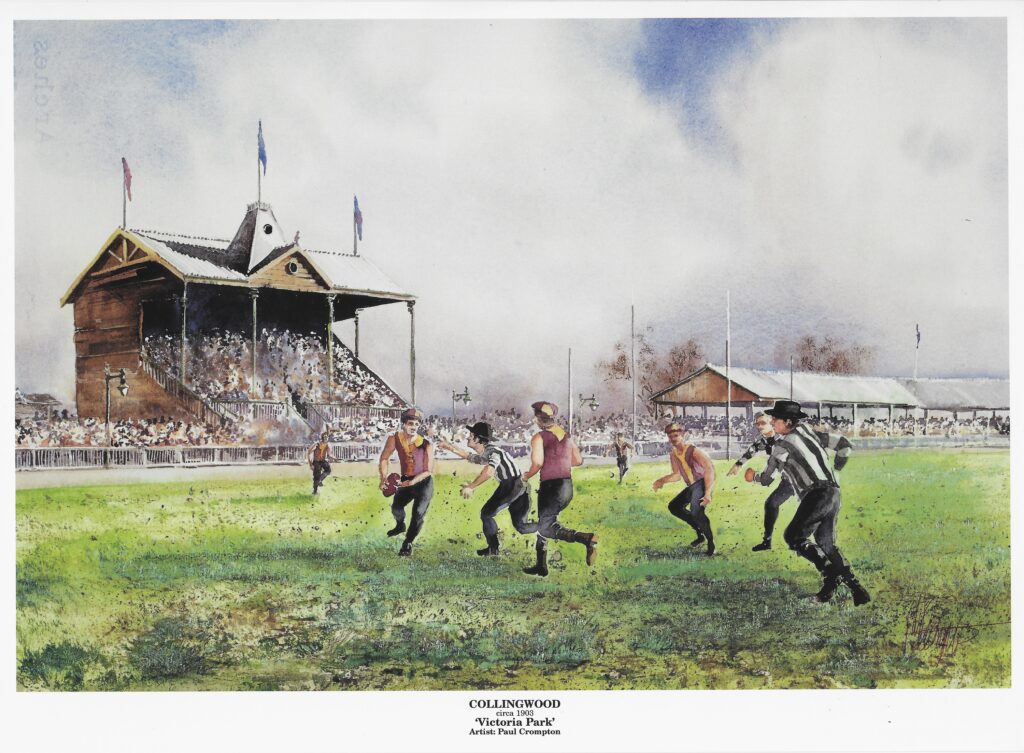
Fitzroy "Brunswick Street Oval"
Fitzroy Football Club played its first game on the Brunswick Street Oval against a team called Richmond Union on April 26 1884, just a few months after the formation of the club. It was a draw with no goals being scored. The Maroons first win was over Melbourne in May. The ground itself had been used by Fitzroy Cricket Club for some years – the grandstand on the right, the Cricket Club stand, was built in the early 1880s. Many of the early footballers were also tremendous cricketers who had taken up this new sport as a means of keeping fit during winter, they included the first two football captains, Paddy McShane and Jack Worrall who also played Test cricket.
The illustration is set in 1906 and shows the football club stand, which opened in 1905 on the left. It burned down in the 1970s and a fire in the cricket pavilion in 1912, destroyed Fitzroy’s first five premiership flags. The cricket stand has been renovated and stands in all its repainted glory. Fitzroy Football club played its last game at Brunswick Street on August 20, 1966.
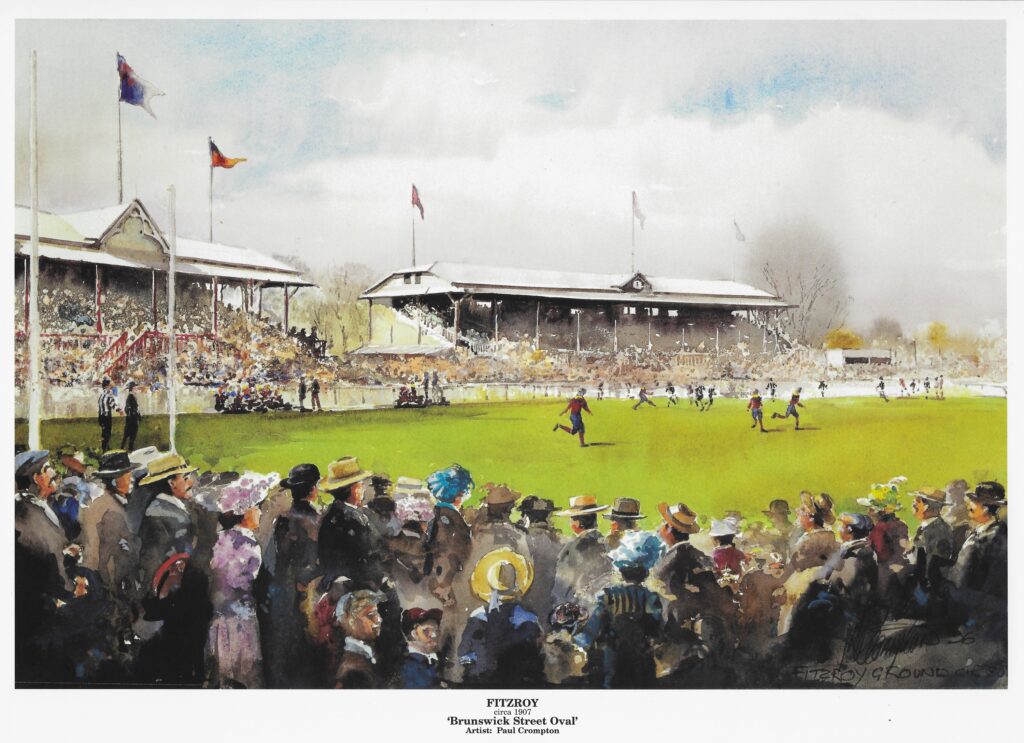
Geelong "Kardinia Park Oval"
The Geelong Football Club was formed in July 1859. Initially its home venue was the Argyle Ground in Aberdeen Street. Later, it moved to Corio Oval in Eastern Park. In 1941 Kardinia Park became its headquarters, previously the oval had hosted local football matches.
The Brownlow-Young Stand, situated on the centre wing, was constructed in 1920. It was named in honour of Charles Brownlow and Henry “Tracker” Young, who were Geelong players and administrators.
The other large stand at the northern end is the A.R. “Jack” Jennings Pavillion. It perpetuates the memory of the Cats’ longest serving President, who was in office for 25 years. The Press-box, for media representatives, and a small past-players’ stand are located on the southern flank.
The record Kardinia Park match attendance was established in 1952 when 49,107 people passed through the gates to watch Geelong defeat Carlton.
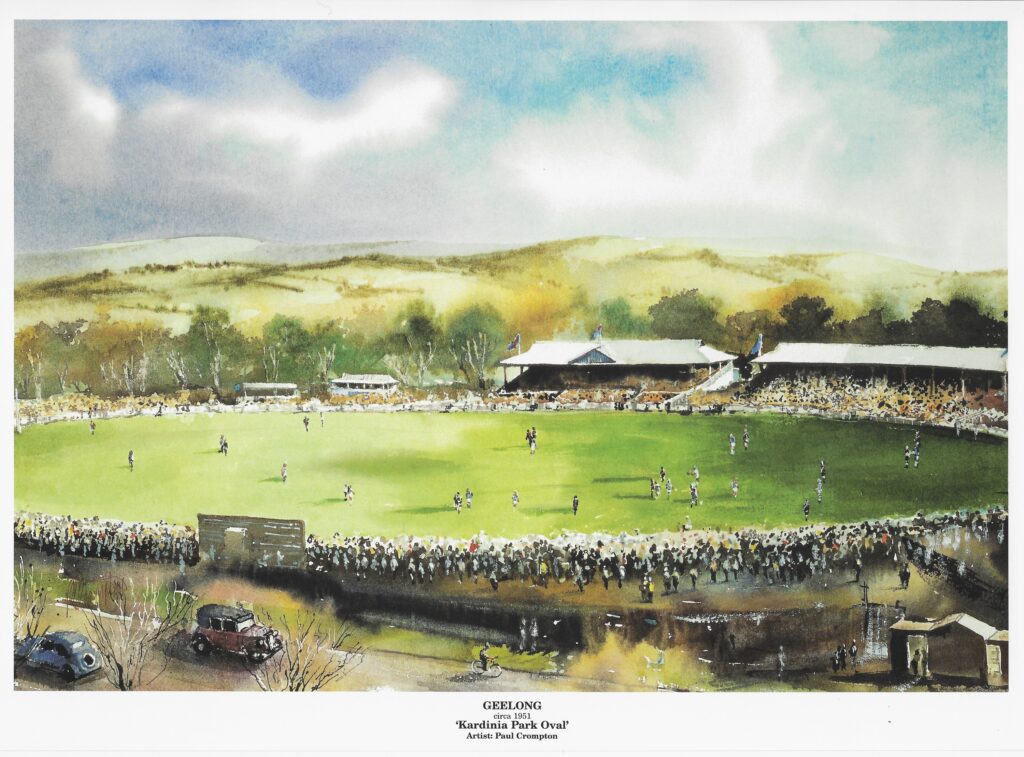
South Melbourne "Lakeside Oval"
The “Lakeside Oval” as it was known, was founded on 20 February 1862 as a cricket ground and remained so until 1994. Australian Rules football was introduced there in 1897 by South Melbourne, nicknamed “The Blood Stained Angels” and later to become “The Swans”.
“The Swans” whose colours have always been red and white, first played in a red and white “hooped” guernsey. This was changed to two vertical stripes in 1904, three stripes in 1905, a red diagonal in 1907 only to be replaced by an all red jumper with a white monogrammed SMC logo in 1921. However this was short lived as the red diagonal stripe came back in 1922 and remained until the big red “V” was introduced in 1933.
The Club won its first premiership in 1909, followed by premierships in 1918 and 1933. The painting depicts the ground as it was at the start of the 1960 Season. The old stand at the north end (top right) of the ground was burnt down in January 1961. The Grandstand survives to this day.
Jim Kennelly Historian
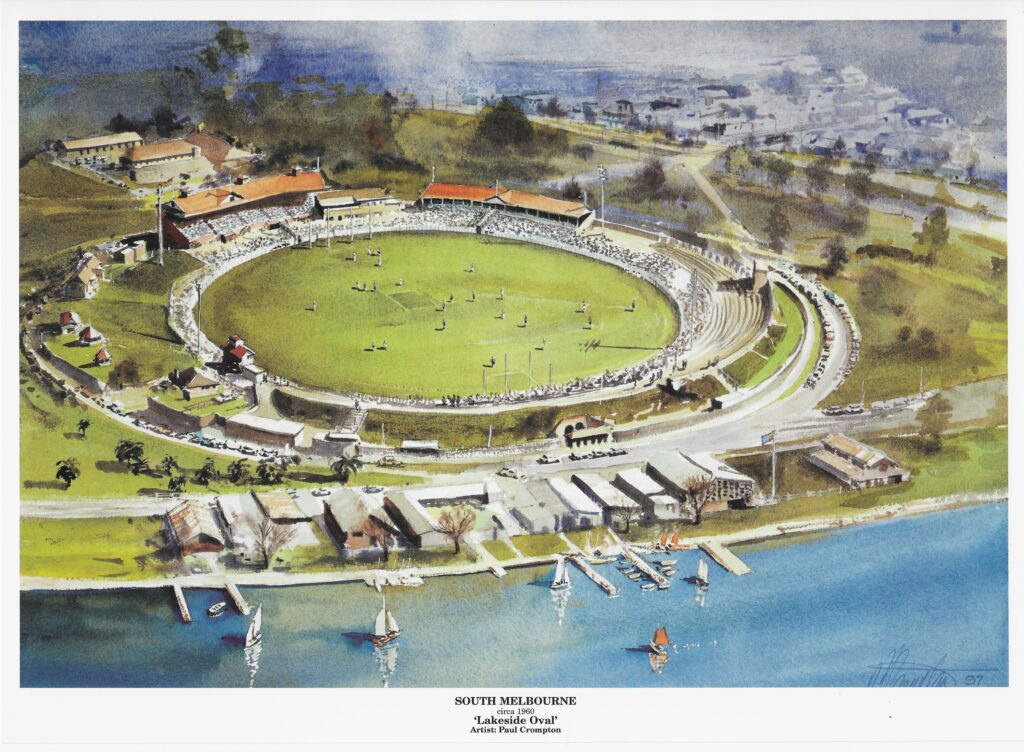
Essendon "Windy Hill"
The Essendon Football Club was established in 1873 and joined the VFA in 18781897, and the VFL (now AFL) in 1897. It was not until 1922 that Essendon used the Essendon ground as its home base, having played for some years at East Melbourne prior to this. The painting shows the “R.S. Reynolds Stand”, built when Essendon took over the ground and which was later extended to provide seating capacity for 1900 spectators in 1976.
Also depicted in the painting is “The A.F. Showers Stand”, built in 1939 following the affiliation of all the clubs using the Essendon ground.
The Essendon ground became known as ‘Windy Hill’ in more recent times.
Club Historian Michael L. Maplestone
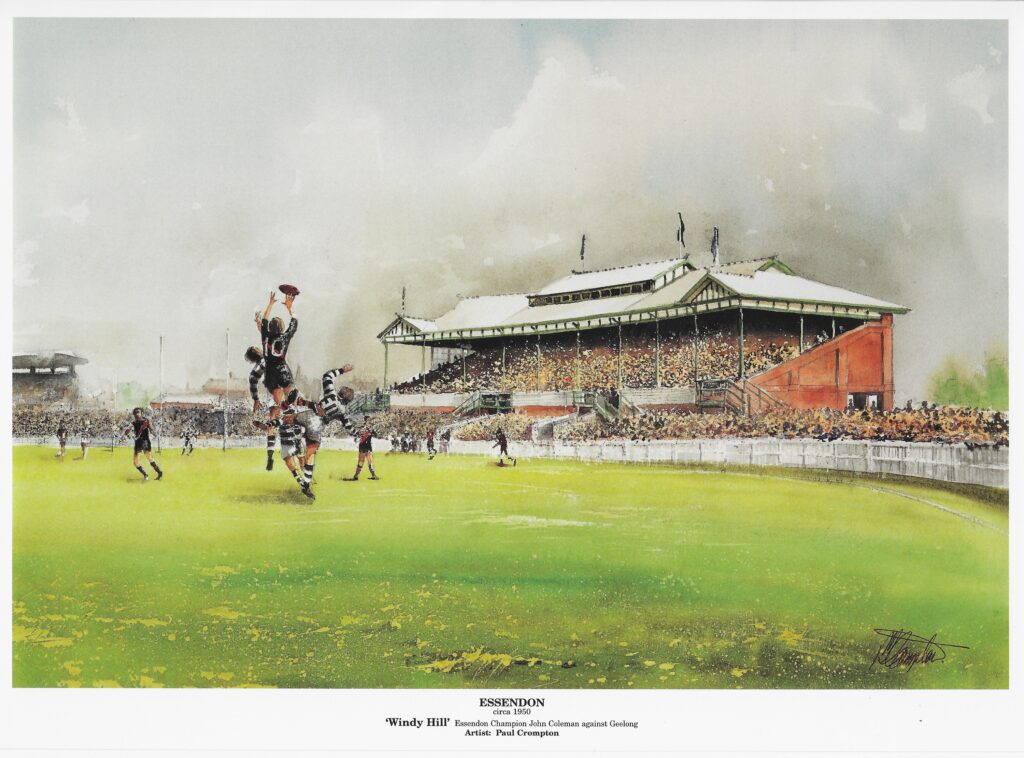
Footscray "Western Oval"
Originally a botanical reserve, the Western Oval became the home for the Footscray Football Club well over a century ago. Footscray entered the VFA competition in 1886 winning premierships in 1898/99, 1900, 1908 and 1913. Footscray dominated the competition between 1919-24 like no other club, recording an amazing 48 consecutive home game victories.
At the end of 1924, Dame Nellie Melba suggested a charity match be played between Footscray (VFA Premiers) and Essendon (VFL Premiers). It was Footscray’s shock victory in the match billed as the “Champions of Victoria” that paved the way for its inclusion in the VFL the following season. The colours red, white and blue have been synonymous with Footscray throughout its history. They were known as the “Tricolours’ in the early years but due to their determination on the field won the title ‘Bulldogs’ which was officially adopted in 1938.
The painting depicts the Western Oval around the time of Footscray’s only premiership in 1954. To honour perhaps the greatest player the game has known, Ted Whitten Snr., The Western Oval’ was re-named the ‘E.J. Whitten Oval’ upon his death in August 1995. The club changed its name to the ‘Western Bulldogs’ for the season 1997.
Darren Arthur (Club Historian and Researcher of A History of the Footscray Football Club: Unleashed) and Ray Stevens (Club Historian) Darren Arthur
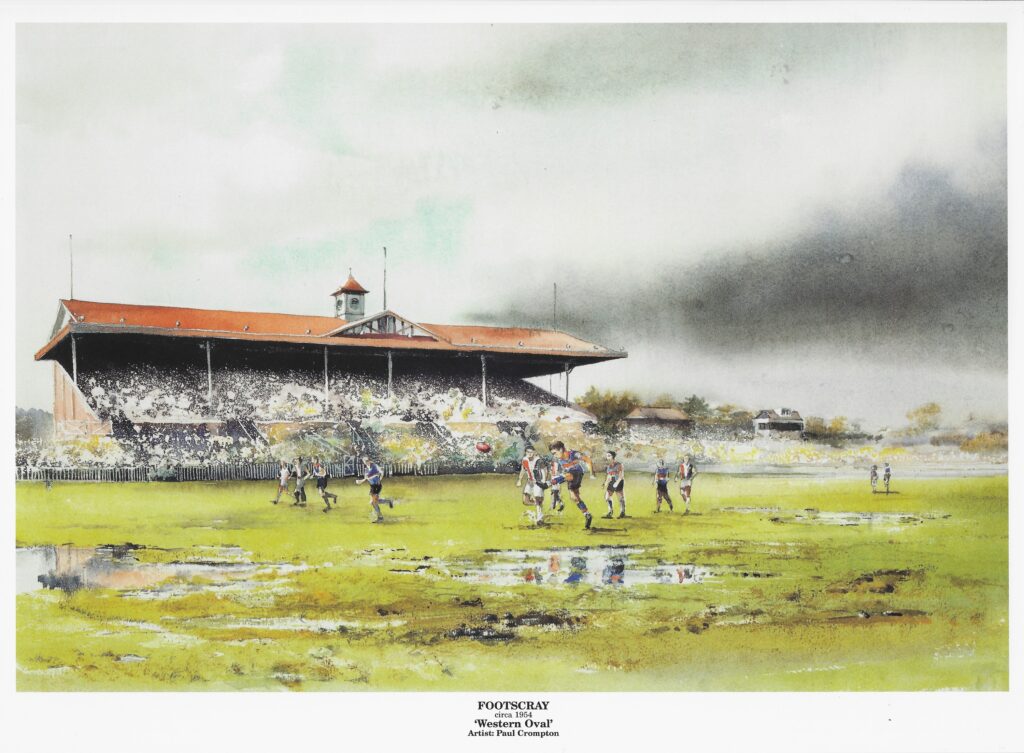
North Melbourne "Arden Street"
The North Melbourne Recreation Reserve popularly known as ‘Arden Street’, has been the home of “North” since 1882. The North Melbourne Football Club (known as Hotham between 1877 and 1887) played its first game here on 29 April 1882 defeating Royal Park 2.9 to 0.2.
In 1906 a wooden grandstand was erected at the Reserve having been brought across
from the Maribyrnong Race Course which had just been closed down. It remained on the site until the 1970’s when the old stand was demolished to make way for the new administration building.
After the old cricket pavilion was demolished, a large brick and timber grandstand was built on the site, and was officially opened on 25 March 1928. The ground is best remembered for the Gasometer located directly opposite the grandstand.
North Melbourne played its last game on the ground on 17 August 1985 against Richmond winning 16.20 to 9.12. ‘Arden Street’ continues to be the administrative and training headquarters of the North Melbourne Football Club.
Gerard Dowling Club Historian and author of “THE NORTH STORY”
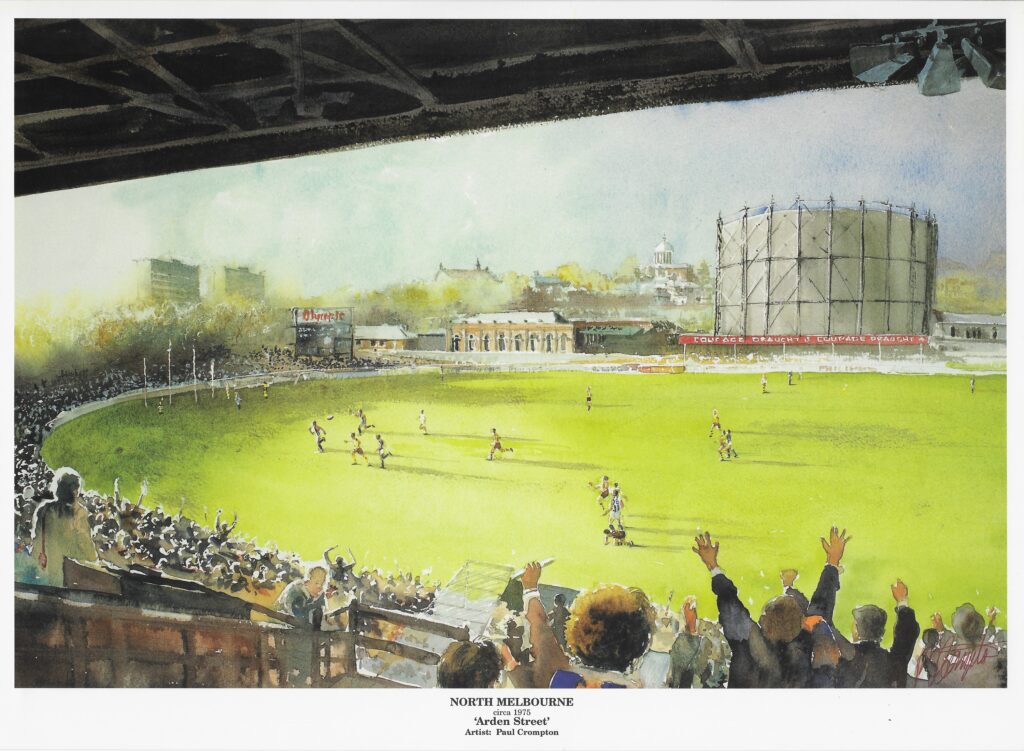
St Kilda Football Club
Like most suburban grounds the Junction Oval was first used for cricket. The St Kilda Football Club played its earliest games in 1873 at the “Alpaca Paddock”, the site of the St Kilda Bowls Club which is situated in the parklands between the Junction Oval and the St Kilda Beach in the painting.
St Kilda Football Club even incorporates the words “I do like to be beside the seaside” in their club song. In 1886 the ground was fenced which enabled the cricket and football clubs to charge admission.
The Junction Oval was renowned as one of the best playing surfaces in Victoria and its grandstands and surrounds had a grace and charm of their own. The old wooden stand at the city end was once the main stand at the Elsternwick racecourse and was transported to the Junction when the old course closed in the 1890s.
When the MCG was taken over by military authorities during World War II the VFL chose to play the 1944 Grand Final at the Junction and 43,000 people saw Fitzroy take out the flag. That wasn’t the record attendance. A total of 47,000 crammed in for a match against Carlton in 1950 when the Saints were on a roll.
St Kilda Football Club moved to Moorabbin in 1965 leaving behind a rich history and plenty of memories.
Russell Holmesby Club Historian and author of Heroes with Haloes
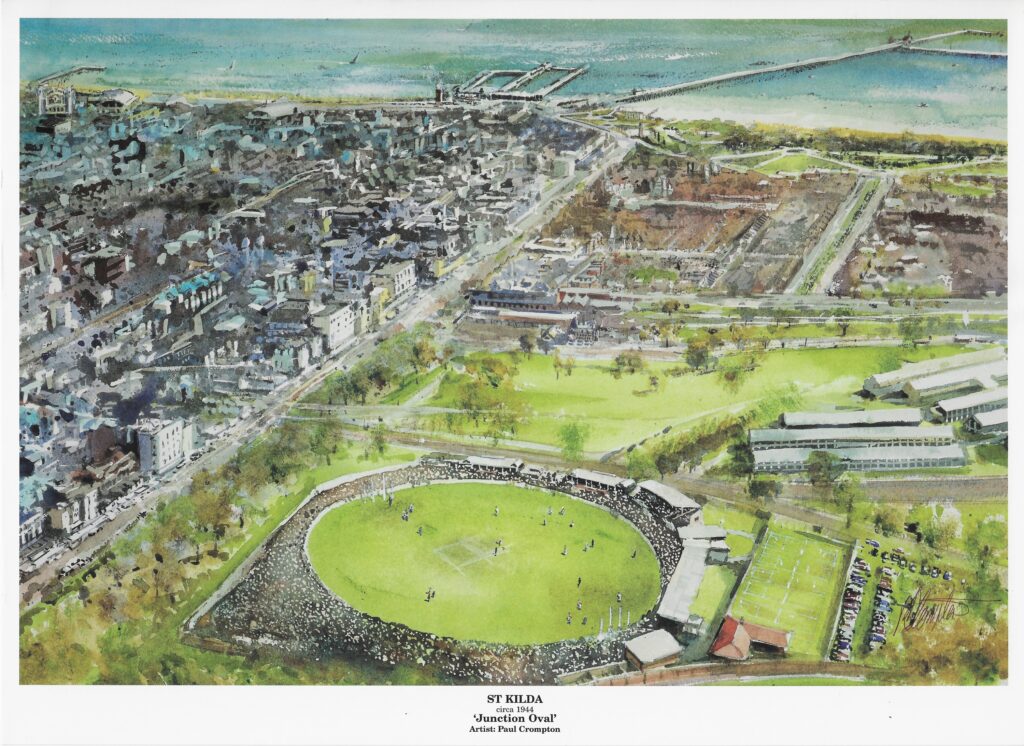
Hawthorne Football Club
[Editor’s note: the following early history of Hawthorn FC is at variance to that currently on Wikipedia]
The club was first established in 1873 and played at St. James Park, Richmond Race Course, Richmond Cricket Ground and the East Melbourne Cricket Ground until the club moved to the Glenferrie Oval in 1906. The ground was officially known as “The Sports Ground” but better known by opposition supporters as the “Sardine Can” due to the very narrow spectator space along the wings. The old wooden stand was relocated from the East Melbourne Cricket Ground in 1922 and later extended to accommodate a timber balcony. Many supporters can still remember how the excitement of the crowd could be felt by the shaking of this timber structure.
Hawthorn colours had changed many times over the years but with their entry to V.F.A. in 1914 they adopted the familiar Brown and Gold. Hawthorn made their only VFA final in 1922 and the club had become known as “The Mayblooms” struggling to win games for many years. The grandstand built in 1938 and known as the “Michael Tuck Stand” has been classified by the National, Trust
The trains always gave a “Toot” and often slowed down to get a better view of the game.
Peter Haby
“HAWKS FOREVER” Historian
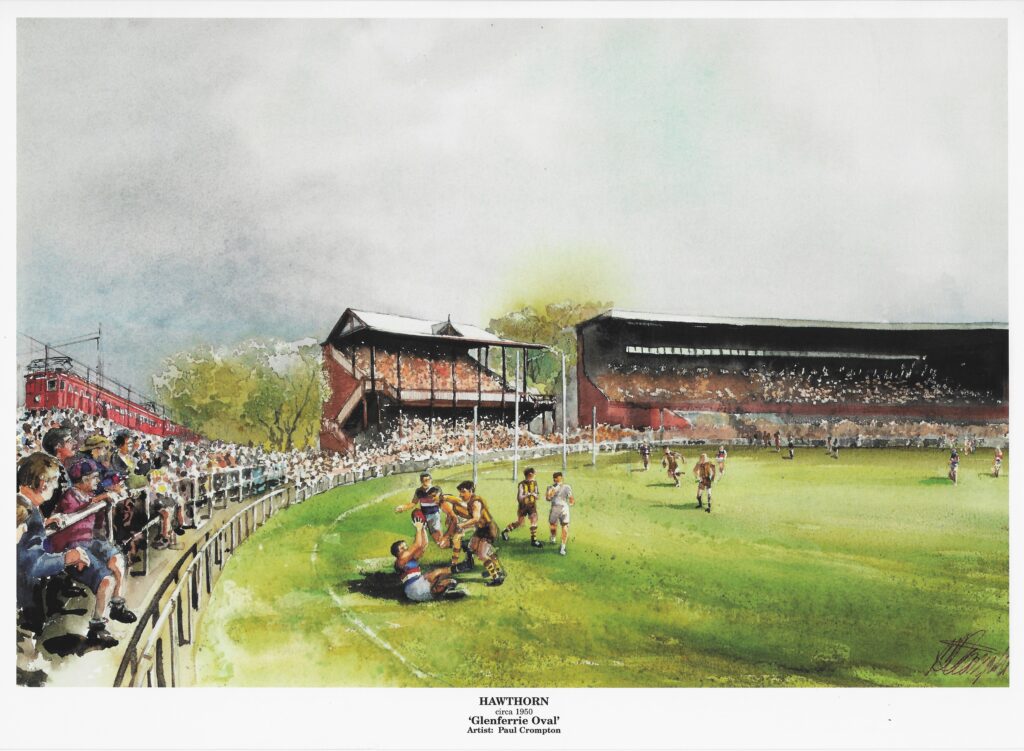
Carlton Football Club
The Carlton Football Club first played on a stretch of high ground in Royal Park in 1864 probably close to where the Burke and Wills statue commemorates the explorers’ departure five years before. By a coincidence the man who sold Burke the expedition camels was George Coppin, the comedian, entrepreneur and politician who was to become the President of Carlton in 1867.
No one was happy with the area, and with the cricket club, the football club set out on a thirty year expedition around Carlton looking for a home. The present ground at the northern end of Princes Park was secured, and the first game played there on June 22, 1897. Between 1876 and 1897 the club played at the southern end of Princes Park, the Madeline Street reserve, where Newman College now stands, Melbourne University Cricket Ground, and at the Triangle’ where the University Women’s College was later built.
The illustration is of Princes Park in 1932, the year the Robert Heatley Stand was opened at a cost of £7000. It was also the year the ‘old stand’ shown here, was named in honour of stalwart Jack Gardiner, player, captain 1876 – 1879, and president 1914-1924. The building to the right appears to be the pavilion relocated from the Triangle, last used in 1897. In 1932 Carlton lost the Grand Final to Richmond, after finishing the home and away series on
top of the ladder. Garry Hutchinson author of ‘100 Years of Australian Football’, From the Outer’, and “The Barrackers Bible’.
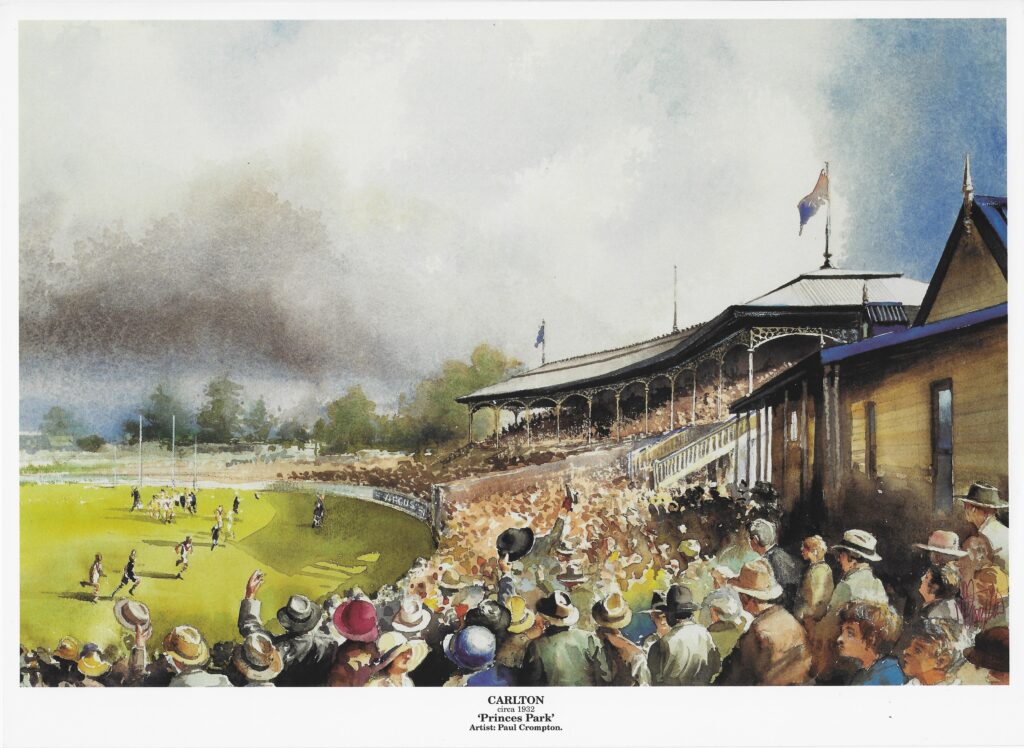
Melbourne Football Club
The Melbourne Cricket Ground and the Melbourne Football Club have always had a close affinity, since the MCG was first used for a charity football match, between the Melbourne Football Club and the Police, in 1869.
Melbourne and Carlton were the first two Association sides to play under lights at the MCG, in mid-August 1879, and from 1891, Melbourne played matches there on a regular basis after becoming a section of the Cricket Club in 1889 – a situation which prevailed until 1980, and saw Melbourne winning twelve premierships in 1900, 1926, 1939, 1940, 1941, 1948, 1955, 1956, 1957, 1959, 1960 and 1964.
The painting shows the MCG circa 1907, complete with the old Members’ Stand, dating from 1886, and demolished for the modern Pavilion in 1927. To the right is the ‘double deck’ northern stand, originally erected in 1884.
Lynda Carroll Club Historian.
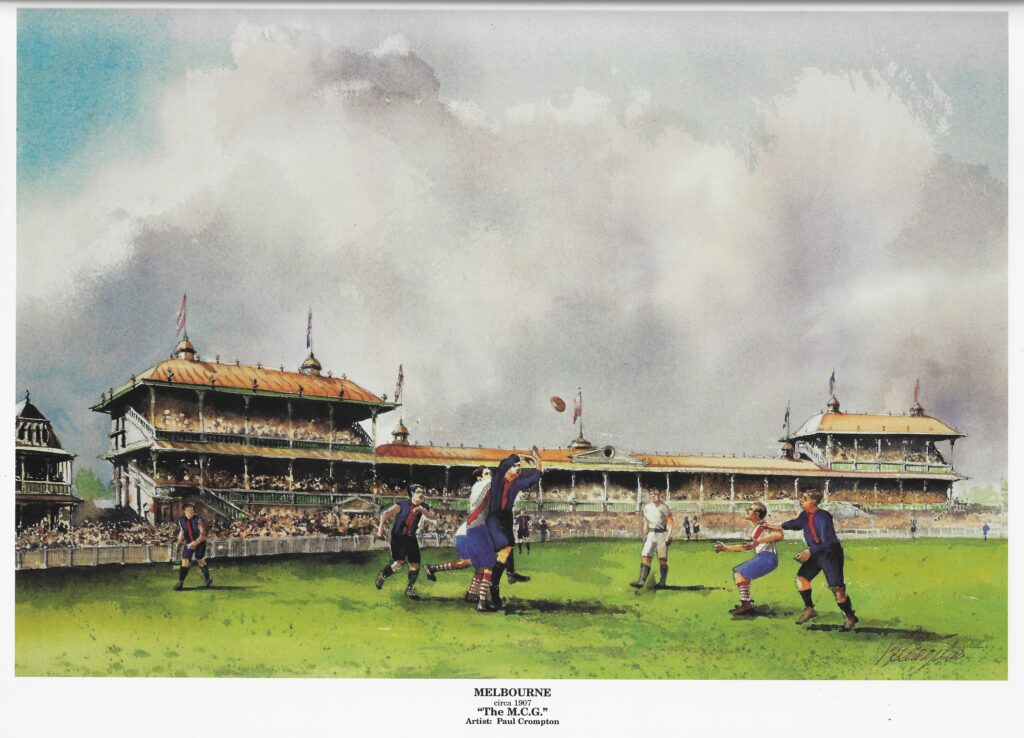
Richmond Football Club
The Richmond Football Club was formed on 20 February 1885 at the Royal Hotel on Punt Road just opposite the oval. The club was entered in the Victorian Football Association (VFA). In 1908 Richmond Football Club joined the Victorian Football League (VFL) which was a stronger breakaway group.
The grandstand was built in 1913 for the Richmond Cricket Club which was formed in 1855. The official opening took place on 6 June 1914 by Andrew Fisher MHR (Prime Minister of Australia).
When it was first built it was 160 feet long, 41 feet wide and 40 feet high. It seated 1,200 people. Including drainage and sewerage the building cost £4,000.
On 14 May 1927 a second wing holding 400-500 people was added at a cost of £2,626-18-8. The public opening was held on 21 May the same year.
Vandals attempted to burn it down in the 1970s and as Richmond was now playing its matches at the MCG it remained in a dilapidated state for many years.
In 1996 a determined administration undertook the immense task of restoring the great building. On 23 March 1997 Jack Dyer Junior opened the building on his father’s behalf. The grandstand is now named “The Jack Dyer Stand’ after the great “Tiger’ legend.
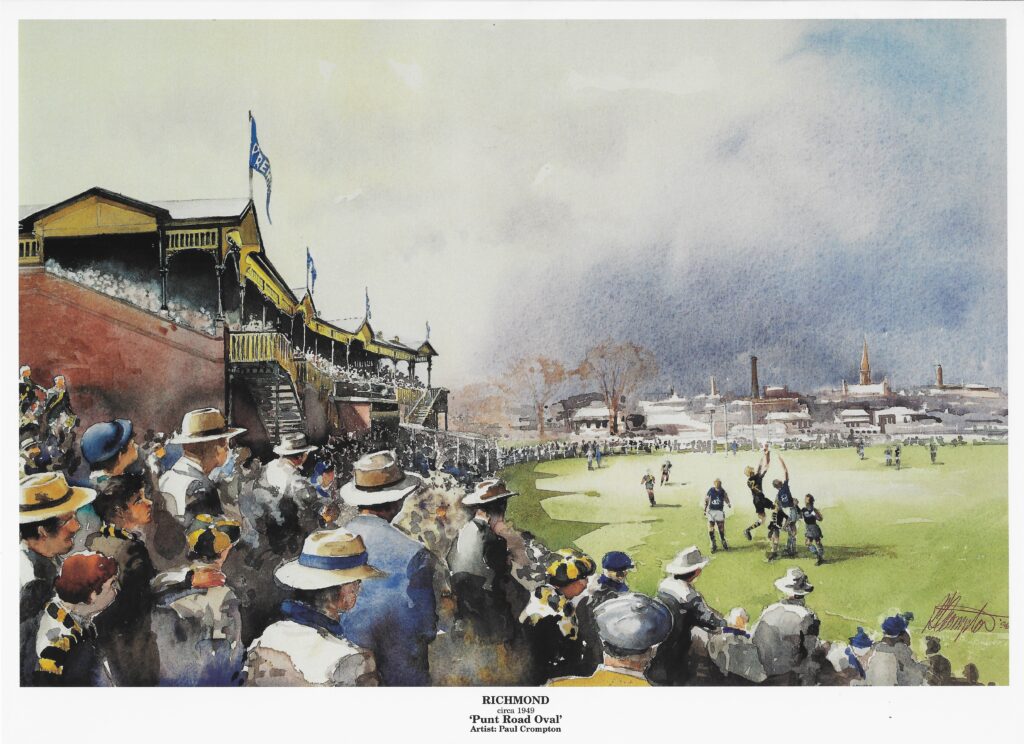
Gallery of all the 12 original Clubs
One added each fortnight
